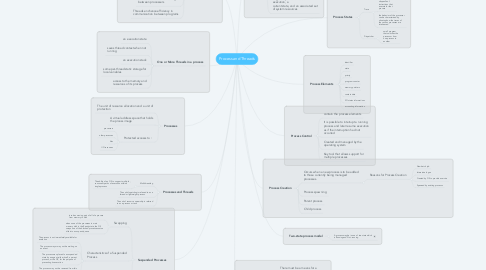
1. Suspended Processes
1.1. Swapping
1.1.1. involves moving part of all of a process from memory to disk
1.1.2. when none of the processes in main memory disk is the Ready state, the OS swaps one of the blocked processesout on disk into a suspend queue
1.2. Characteristics of a Suspended Process
1.2.1. The process is not immediately available for execution
1.2.2. The process mayor may not be waiting on an event
1.2.3. The process was placed in a suspended state by an agent ;either itself ,a parent process, or the OS, for the purpose of preventing its execution
1.2.4. The process may not be removed from this state until the agent explicitly ordes the removal
1.3. Reasons for Process Supnsion
1.3.1. Swapping
1.3.2. Other OS reason
1.3.3. Interactive user request
1.3.4. Timing
1.3.5. Parent process request
2. Processes and Threads
2.1. Multithreading
2.1.1. The ability of an OS to support multiple , consurrent paths of execution within a single process
2.2. The unit dispatchng is referred to as a thread or lightweight process
2.3. The unit of resource ownership is referred to as a process or task
3. Processes
3.1. The unit of resource allocation and a unit of protection
3.2. A virtual address space that holds the prcess image
3.3. Protected accesss to :
3.3.1. processors
3.3.2. other processes
3.3.3. files
3.3.4. I/O resources
4. One or More Threads in a process
4.1. an execution state
4.2. saves thread context when not runnng
4.3. an execution stack
4.4. some per-thread static storage for local variables
4.5. access to the memory and resources of its process
5. Benefits of Threads
5.1. Takes less time to create a new thread than a process
5.2. Less time to terminate a thread than a process
5.3. Switching between two threads takes less time than switching between processers
5.4. Threads enchance efficiency in communication between programs
6. Process
6.1. a progarm in execution
6.2. an instance of a running program
6.3. the entity that can be assigned to, and executed on, a processor
6.4. a unit of activity characterized by a single sequential thread of execution, a current state, and an associated set of system resources
7. Process Elements
7.1. identifier
7.2. state
7.3. priorty
7.4. program counter
7.5. memory pointers
7.6. context data
7.7. I/O status informations
7.8. accounting information
8. Process Control
8.1. contain the process elements
8.2. It is possible to interrupt a running process and later resume execution as if the interruption had not occurred
8.3. Created and managed by the operating system
8.4. Key tool that allows support for multiple processes
9. Two-state process model
9.1. A process may be in one of two state which is Running and Not- running
10. Process States
10.1. Trace
10.1.1. the behavior of an individual process by listing the sequence of instructions that execute for that process
10.1.2. the behavior of the processor can be characterized by showing how the traces of the various processes are interleaved
10.2. Dispatcher
10.2.1. small program that switches the processor from one process to another
11. Process Creation
11.1. Occurs when a new process is to be added to those currently being managed processes.
11.1.1. Reasons for Process Creation
11.1.1.1. New batch job
11.1.1.2. Interactive logon
11.1.1.3. Created by OS to provide a service
11.1.1.4. Spawned by existing processs
